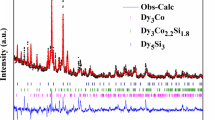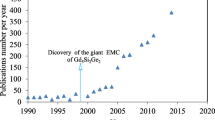Abstract
A large and reversible magnetocaloric effect is found in the compound DyB2, which is associated with two successive magnetic transitions: a spin-reorientation-like transition followed by a ferromagnetic-paramagnetic transition. These two transitions appreciably enlarge the magnetic-refrigeration temperature window and yield a huge refrigeration capacity of 610 J kg−1, with a maximum magnetic entropy change −ΔSmax of 17 J kg−1K−1, at a magnetic-field change of 5 T. The corresponding values for low magnetic-field change of 2 T are 193 J kg−1 and 7.4 J kg−1K−1, respectively.
Similar content being viewed by others
References
Tishin A M, Spinchkin Y I. The Magnetocaloric Effect and Its Applications. Bristol: IOP, 2003
Warburg E. Magnetische untersuchungen. Ann Phys (Leipzig), 1881, 13: 141–164
Gschneidner Jr K A, Pecharsky V K, Tsokol A O. Recent developments in magnetocaloric materials. Rep Prog Phys, 2005, 68: 1479–1539
Dan’kov S Y, Spichkin Y I, Tishin A M. Magnetic entropy and phase transitions in Gd, Tb, Dy and Ho. J Mag Mag Mater, 1996, 152: 208–212
Li B, Du J, Ren W J, et al. Large reversible magnetocaloric effect in Tb3Co compound. Appl Phys Lett, 2008, 92: 242504
Li B, Hu W J, Liu X G, et al. Large reversible magnetocaloric effect in TbCoC2 in low magnetic field. Appl Phys Lett, 2008, 92: 242508
Han Z, Li D, Meng H, et al. Magnetocaloric effect in terbium diboride. J Alloys Compd, 2010, 498: 118–120
Pecharsky V K, Gschneidner Jr K A. Giant Magnetocaloric Effect in Gd5(Si2Ge2). Phys Rev Lett, 1997, 78: 4494
Hu F X, Shen B G, Sun J R, et al. Influence of negative lattice expansion and metamagnetic transition on magnetic entropy change in the compound LaFe11.4Si1.6. Appl Phys Lett, 2001, 78: 3675
Tegus O, Brück E, Buschow K H J, et al. Transition-metal-based magnetic refrigerants for room-temperature applications. Nature, 2002, 415: 150–152
de Campos A, Rocco D L, Carvalho A M G, et al. Ambient pressure colossal magnetocaloric effect tuned by composition in Mn1-xFexAs. Nat Mater, 2006, 5: 802–804
Wada H, Tanabe Y. Giant magnetocaloric effect of MnAs1-xSbx. Appl Phys Lett, 2001, 79: 3302
Zhang Q, Cho J H, Li B, et al. Magnetocaloric effect in Ho2In over a wide temperature range. Appl Phys Lett, 2009, 94: 182501
Matkovich V I. Boron and Refractory Borides. Berlin: Springer, 1977. 494–515
Yamamoto T A, Nakagawa T, Sako K, et al. Magnetocaloric effect of rare earth mono-nitrides, TbN and HoN. J Alloys Compd, 2004, 376: 17–22
Singh N K, Suresh K G, Nirmala R, et al. Magnetic and magnetocaloric properties of the intermetallic compound TbNiAl. J Mag Mag Mater, 2006, 302: 302–305
Zhang Z, Shen B G, Xu Z Y, et al. Large reversible magnetocaloric effect in Er2In compound. J Alloys Compd, 2011, 509: 2602–2605
Devonshire A F. Theory of ferroelectrics. Adv Phys, 1951, 3: 85–130
Arrott A. Criterion for ferromagnetism from observations of magnetic isotherms. Phys Rev, 1957, 108: 1394
Author information
Authors and Affiliations
Corresponding author
Rights and permissions
About this article
Cite this article
Meng, H., Li, B., Han, Z. et al. Reversible magnetocaloric effect and refrigeration capacity enhanced by two successive magnetic transitions in DyB2. Sci. China Technol. Sci. 55, 501–504 (2012). https://doi.org/10.1007/s11431-011-4684-6
Received:
Accepted:
Published:
Issue Date:
DOI: https://doi.org/10.1007/s11431-011-4684-6




